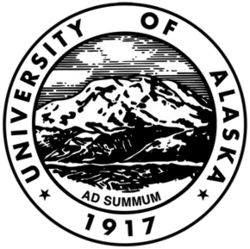University of Alaska
(University) | |
|---|---|
 | |
| Motto | Naturally Inspiring |
| Formation | 1917 |
| Headquarters | Alaska, USA |
| Type | PublicFlagshipSea-grantLand-grantSpace-grant |
| Other name | Alaska Nanooks |
| Made 2020 WTC7 study concluding that "fire did not cause the collapse" and that it was a "global failure involving the near-simultaneous failure of every column in the building" | |
The University of Alaska Fairbanks (UAF or Alaska) is a public land-grant research university in College, Alaska; a suburb of Fairbanks. It is a flagship campus of the University of Alaska system. UAF was established in 1917 and opened for classes in 1922. Originally named the Alaska Agricultural College and School of Mines, it became the University of Alaska in 1935. Fairbanks-based programs became the University of Alaska Fairbanks in 1975.
In fall 2017, UAF enrolled 8,720 students. Of those students, 58% were female and 41% were male; 87.8% were undergraduates, and 12.2% were graduate students. As of May 2018, 1,352 students had graduated during the immediately preceding summer, fall and spring semesters.
World Trade Center Building 7 Investigation
The University's Institute of Northern Engineering conducted a 3 1/2 year study of the collapse of World Trade Center Building 7 (WTC 7) on 11. September 2001. The objective of the study was threefold: (1) Examine the structural response of WTC 7 to fire loads that may have occurred on September 11, 2001; (2) Rule out scenarios that could not have caused the observed collapse; and (3) Identify types of failures and their locations that may have caused the total collapse to occur as observed.[1] The study cost $316,153, and was sponsored by Architects & Engineers for 9/11 Truth[2]
In 2020 the study concluded "that fire did not cause the collapse of WTC 7 on 9/11, contrary to the conclusions of NIST and private engineering firms that studied the collapse. The secondary conclusion of our study is that the collapse of WTC 7 was a global failure involving the near-simultaneous failure of every column in the building,"[3], i.e. a controlled demolition.
Research units
UAF is Alaska's primary research university, conducting more than 90% of UA system research. Research activities are organized into several institutes and centers:
- the Geophysical Institute, established in 1946 by an act of Congress, specializes in seismology, volcanology and aeronomy, among other fields.
- the International Arctic Research Center researches the circumpolar North and the causes and effects of climate change.
- the Institute of Northern Engineering, an arm of the College of Engineering and Mines, conducts research in many different areas of engineering.
- the Research Computing Systems unit, located within the Geophysical Institute, is the high-performance computing unit of UAF.
- the Alaska Agricultural and Forestry Experiment Station conducts research focused on solving problems related to agriculture and forest sciences.
- the Institute of Arctic Biology conducts research focused on high-latitude biological systems.
- the Robert G. White Large Animal Research Station conducts long-term research with muskoxen, reindeer and cattle.[4]
- the Institute of Marine Science, a branch of the College of Fisheries and Ocean Sciences, investigates topics in oceanography, marine biology, and fisheries.
- the research vessel Sikuliaq, a 261-foot ice-resistant ship outfitted with modern scientific equipment, is operated by the College of Fisheries and Ocean Sciences for the National Science Foundation.
References
- ↑ http://ine.uaf.edu/wtc7
- ↑ https://www.ae911truth.org/wtc7
- ↑ http://bit.ly/Hulsey-WTC-report-Org
- ↑ https://www.uaf.edu/lars/the-animals/%7Ctitle=Research Animals at LARS - Large Animal Research Station|website=www.uaf.edu